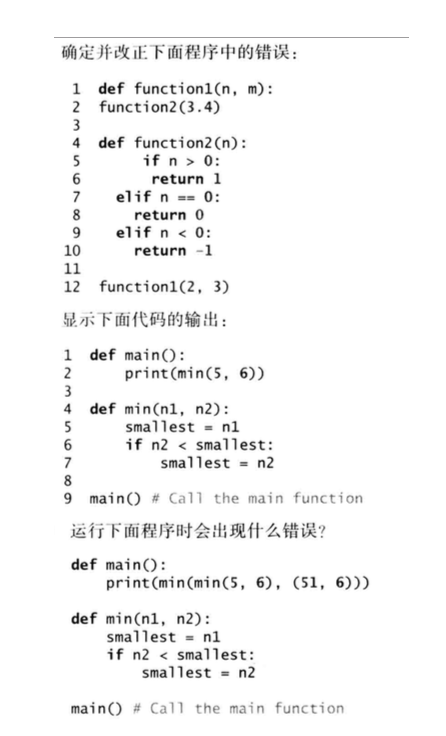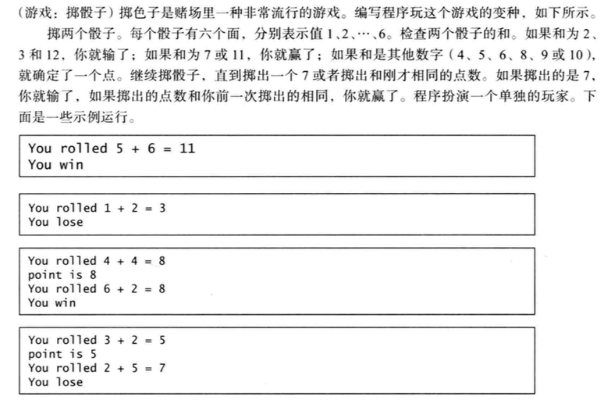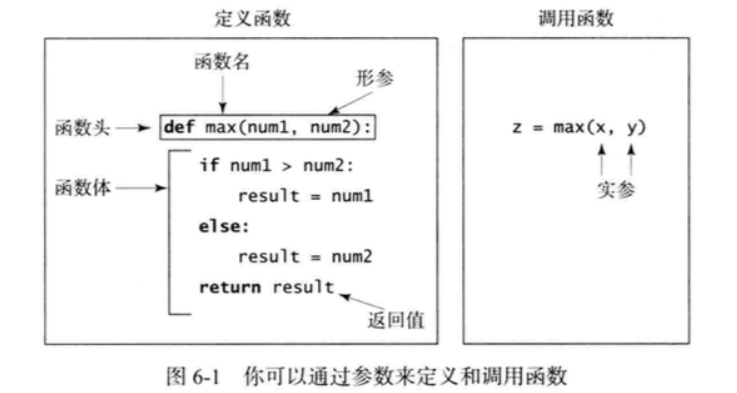Python_4day
函数
- 函数可以用来定义可重复代码,组织和简化
- 一般来说一个函数在实际开发中为一个小功能
- 一个类为一个大功能
- 同样函数的长度不要超过一屏
Python中的所有函数实际上都是有返回值(return None),
如果你没有设置return,那么Python将不显示None.
如果你设置return,那么将返回出return这个值.
- def HJN():
- print('Hello')
- return 1000
- b=HJN()
- print(b)
- Hello
- 1000
- HJN
- <function __main__.HJN()>
- def panduan(number):
- if number % 2 == 0:
- print('O')
- else:
- print('J')
- panduan(number=1)
- J
- panduan(2)
- O
定义一个函数
def function_name(list of parameters):
do something

- 以前使用的random 或者range 或者print.. 其实都是函数或者类
函数的参数如果有默认值的情况,当你调用该函数的时候: 可以不给予参数值,那么就会走该参数的默认值 否则的话,就走你给予的参数值.
- import random
- def hahah():
- n = random.randint(0,5)
- while 1:
- N = eval(input('>>'))
- if n == N:
- print('smart')
- break
- elif n < N:
- print('太小了')
- elif n > N:
- print('太大了')
-
调用一个函数
- functionName()
- "()" 就代表调用
- def H():
- print('hahaha')
- def B():
- H()
- B()
- hahaha
- def A(f):
- f()
- A(B)
- hahaha


带返回值和不带返回值的函数
- return 返回的内容
- return 返回多个值
- 一般情况下,在多个函数协同完成一个功能的时候,那么将会有返回值


- 当然也可以自定义返回None
EP:


- def main():
- print(min(min(5,6),(51,6)))
- def min(n1,n2):
- a = n1
- if n2 < a:
- a = n2
- main()
- ---------------------------------------------------------------------------
- TypeError Traceback (most recent call last)
- <ipython-input-9-263240bbee7e> in <module>
- ----> 1 main()
- <ipython-input-8-a7c84f32bfda> in main()
- 1 def main():
- ----> 2 print(min(min(5,6),(51,6)))
- 3 def min(n1,n2):
- 4 a = n1
- 5 if n2 < a:
- <ipython-input-8-a7c84f32bfda> in min(n1, n2)
- 3 def min(n1,n2):
- 4 a = n1
- ----> 5 if n2 < a:
- 6 a = n2
- TypeError: '<' not supported between instances of 'tuple' and 'NoneType'
类型和关键字参数
- 普通参数
- 多个参数
- 默认值参数
- 不定长参数
普通参数
多个参数
默认值参数
强制命名
- def U(str_):
- xiaoxie = 0
- for i in str_:
- ASCII = ord(i)
- if 97<=ASCII<=122:
- xiaoxie +=1
- elif xxxx:
- daxie += 1
- elif xxxx:
- shuzi += 1
- return xiaoxie,daxie,shuzi
- U('HJi12')
- H
- J
- i
- 1
- 2
不定长参数
- *args
- 不定长,来多少装多少,不装也是可以的
- 返回的数据类型是元组
- args 名字是可以修改的,只是我们约定俗成的是args
- **kwargs
- 返回的字典
- 输入的一定要是表达式(键值对)
- name,*args,name2,**kwargs 使用参数名
- def TT(a,b)
- def TT(*args,**kwargs):
- print(kwargs)
- print(args)
- TT(1,2,3,4,6,a=100,b=1000)
- {'a': 100, 'b': 1000}
- (1, 2, 3, 4, 6)
- {'key':'value'}
- ()
- TT(1,2,4,5,7,8,9,)
- (1, 2, 4, 5, 7, 8, 9)
- def B(name1,nam3):
- pass
- B(name1=100,2)
- File "<ipython-input-39-bd6a38e58465>", line 1
- B(name1=100,2)
- ^
- SyntaxError: positional argument follows keyword argument
- def sum_(*args,A='sum'):
- res = 0
- count = 0
- for i in args:
- res +=i
- count += 1
- if A == "sum":
- return res
- elif A == "mean":
- mean = res / count
- return res,mean
- else:
- print(A,'还未开放')
- sum_(-1,0,1,4,A='var')
- var 还未开放
- 'aHbK134'.__iter__
- b = 'asdkjfh'
- for i in b :
- print(i)
- a
- s
- d
- k
- j
- f
- h
- 2,5
- 2 + 22 + 222 + 2222 + 22222
变量的作用域
- 局部变量 local
- 全局变量 global
- globals 函数返回一个全局变量的字典,包括所有导入的变量
- locals() 函数会以字典类型返回当前位置的全部局部变量。
- a = 1000
- b = 10
- def Y():
- global a,b
- a += 100
- print(a)
- Y()
- 1100
- def YY(a1):
- a1 += 100
- print(a1)
- YY(a)
- print(a)
- 1200
- 1100
注意:
- global :在进行赋值操作的时候需要声明
- 官方解释:This is because when you make an assignment to a variable in a scope, that variable becomes local to that scope and shadows any similarly named variable in the outer scope.


Homework
- 1


- import math
- def getPentagonalNumber():
- count = 0
- for i in range(1, 101):
- a = i * ( 3*i - 1) / 2
- print(int(a),end = ' ')
- count += 1
- if count % 10 == 0:
- print('\n')
- getPentagonalNumber()
- 2


- def sumDigits(n):
- a = n % 10
- b = n // 100
- c = (n // 10) - ((n // 100)*10)
- d = a + b + c
- print(d)
- sumDigits(234)
- 9
- 3


- def displaySortedNumbers(num1,num2,num3):
- if num1 > num2 > num3:
- print(num1,num2,num3)
- elif num1 > num3 > num2:
- print(num1,num3,num2)
- elif num2 > num1 > num3:
- print(num2,num1,num3)
- elif num2 > num3 > num1:
- print(num2,num3,num1)
- elif num3 > num1 > num2:
- print(num3,num1,num2)
- elif num3 > num2 > num1:
- print(num3,num2,num1)
- displaySortedNumbers(3,8,1)
- 8 3 1
- 4


- def futureInvestmentValue(principal,rate,years):
- for i in range(years):
- principal = principal * (1+rate)
- print("{}年内总额{}: ".format(i+1,principal))
- principal = eval(input("输入存款金额: "))
- rate = eval(input("输入利率: "))
- years = eval(input("输入年份:" ))
- futureInvestmentValue(principal,rate,years)
- 输入存款金额: 10000
- 输入利率: 0.003
- 输入年份:10
- 1年内总额10029.999999999998:
- 2年内总额10060.089999999997:
- 3年内总额10090.270269999995:
- 4年内总额10120.541080809995:
- 5年内总额10150.902704052423:
- 6年内总额10181.35541216458:
- 7年内总额10211.899478401072:
- 8年内总额10242.535176836274:
- 9年内总额10273.262782366783:
- 10年内总额10304.082570713881:
- 5


- li = [chr(i) for i in range(ord("A"),ord("Z")+1)]
- count=0
- for i in li:
- print(i,end=' ')
- count += 1
- if(count%10==0):
- print(end='\n')
- A B C D E F G H I J
- K L M N O P Q R S T
- U V W X Y Z
- 6


- import math
- def numberOfDaysInAYear():
- for i in range(2010,2021):
- if i % 4 == 0 and i % 100 != 0 or i % 400 == 0:
- print(i,'是366天')
- else:
- print(i,'是365天')
- numberOfDaysInAYear()
- 2010 是365天
- 2011 是365天
- 2012 是366天
- 2013 是365天
- 2014 是365天
- 2015 是365天
- 2016 是366天
- 2017 是365天
- 2018 是365天
- 2019 是365天
- 2020 是366天
- 7


- import numpy as np
- import math
- def xsj(x1,y1,x2,y2):
- p1=np.array([x1,y1])
- p2=np.array([x2,y2])
- p3=p2-p1
- p4=math.hypot(p3[0],p3[1])
- print(p4)
- x1,y1,x2,y2=map(int,input().split(','))
- xsj(x1,y1,x2,y2)
- 1,2,3,4
- 2.8284271247461903
- 8


- def a():
- for i in range(2, 32):
- p = (2 ** i) - 1
- print(i,p)
- a()
- 9



- import time
-
- localtime = time.asctime(time.localtime(time.time()))
- print("本地时间为 :", localtime)
-
- 本地时间为 : Sun Aug 4 19:00:10 2019
- 10


- import random
- random1 = random.randint(1,7)
- random2 = random.randint(1,7)
- random3 = random.randint(1,7)
- total = random1 + random2
- print('第一次摇到:{}'.format(random1))
- print('第二次摇到:{}'.format(random2))
- if total ==7 or total==11:
- print('{}+{}={} you win!'.format(random1,random2,total))
- elif total ==2 or total==3 or total ==12:
- print('{}+{}={} you lose!'.format(random1,random2,total))
- elif total==4 or total ==5 or total==6 or total==8 or total==9 or total==10:
- total=total+random3
- print('第三次摇到:{}'.format(random3))
- print('diercihe{}'.format(total))
- 第一次摇到:2
- 第二次摇到:1
- 2+1=3 you lose!
- 11
去网上寻找如何用Python代码发送邮件
- import smtplib
- from email.mime.text import MIMEText
-
-
- def send_mail(username, passwd, recv, title, content, mail_host='smtp.163.com', port=25):
- '''
- 发送邮件函数,默认使用163smtp
- :param username: 邮箱账号 xx@163.com
- :param passwd: 邮箱密码
- :param recv: 邮箱接收人地址,多个账号以逗号隔开
- :param title: 邮件标题
- :param content: 邮件内容
- :param mail_host: 邮箱服务器
- :param port: 端口号
- :return:
- '''
- msg = MIMEText(content) # 邮件内容
- msg['Subject'] = title # 邮件主题
- msg['From'] = username # 发送者账号
- msg['To'] = recv # 接收者账号列表
- smtp = smtplib.SMTP(mail_host, port=port) # 连接邮箱,传入邮箱地址,和端口号,smtp的端口号是25
- smtp.login(username, passwd) # 发送者的邮箱账号,密码
- smtp.sendmail(username, recv, msg.as_string())
- # 参数分别是发送者,接收者,第三个是把上面的发送邮件的内容变成字符串
- smtp.quit() # 发送完毕后退出smtp
- print('email send success.')
-
-
- email_user = 'xxxx@163.com' # 发送者账号
- email_pwd = 'xxxxx' # 发送者密码
- maillist = 'XXX@XXX.com'
- title = '测试邮件标题'
- content = '这里是邮件内容'
- send_mail(email_user, email_pwd, maillist, title, content)
- ---------------------------------------------------------------------------
- SMTPAuthenticationError Traceback (most recent call last)
- <ipython-input-4-240ad3b9e6b5> in <module>
- 32 title = '测试邮件标题'
- 33 content = '这里是邮件内容'
- ---> 34 send_mail(email_user, email_pwd, maillist, title, content)
- <ipython-input-4-240ad3b9e6b5> in send_mail(username, passwd, recv, title, content, mail_host, port)
- 20 msg['To'] = recv # 接收者账号列表
- 21 smtp = smtplib.SMTP(mail_host, port=port) # 连接邮箱,传入邮箱地址,和端口号,smtp的端口号是25
- ---> 22 smtp.login(username, passwd) # 发送者的邮箱账号,密码
- 23 smtp.sendmail(username, recv, msg.as_string())
- 24 # 参数分别是发送者,接收者,第三个是把上面的发送邮件的内容变成字符串
- D:\anacoda\lib\smtplib.py in login(self, user, password, initial_response_ok)
- 728
- 729 # We could not login successfully. Return result of last attempt.
- --> 730 raise last_exception
- 731
- 732 def starttls(self, keyfile=None, certfile=None, context=None):
- D:\anacoda\lib\smtplib.py in login(self, user, password, initial_response_ok)
- 719 (code, resp) = self.auth(
- 720 authmethod, getattr(self, method_name),
- --> 721 initial_response_ok=initial_response_ok)
- 722 # 235 == 'Authentication successful'
- 723 # 503 == 'Error: already authenticated'
- D:\anacoda\lib\smtplib.py in auth(self, mechanism, authobject, initial_response_ok)
- 640 if code in (235, 503):
- 641 return (code, resp)
- --> 642 raise SMTPAuthenticationError(code, resp)
- 643
- 644 def auth_cram_md5(self, challenge=None):
- SMTPAuthenticationError: (535, b'Error: authentication failed')
Python_4day的更多相关文章
随机推荐
- A. Odds and Ends(思维)
A. Odds and Ends time limit per test 1 second memory limit per test 256 megabytes input standard inp ...
- Suitable Replacement
D. Suitable Replacement 这个题统计出 s 和 t 中的各字母个数以及"?"的个数,直接暴力即可,s中不足的字母可用 "?"来替代 这个题 ...
- HDU 5867 Water problem ——(模拟,水题)
我发这题只是想说明:有时候确实需要用水题来找找自信的~ 代码如下: #include <stdio.h> #include <algorithm> #include <s ...
- $\LaTeX$数学公式大全3
$3\ Delimiters$$|$ |$\vert$ \vert$\|$ \|$\Vert$ \Vert$\{$ \{$\}$ \}$\langle$ \langle$\rangle$ \rangl ...
- JAVA中随机生成确定范围内的随机数
最近工作中的一个业务需要再确定范围内取出一个随机数,网上到时搜出来一堆可以实现的方法,但是鄙人仍是理解不了,虽说已经copy方法直接完成工作了.今天抽时间整理下,希望能够帮助大家更好的理解随机数的实现 ...
- Maven :Failed to execute goal on projectt ...: Could not resolve dependencies for project ...
Maven 项目运行 clean install 之前,先要运行父项目的 clean install, 否则可能出现 Failed to execute goal on project ...: C ...
- 图片上传(前端显示预览,后端php接收)
html: <form action="{:Url('do_ls_law_upload')}" method="POST" accept-charset= ...
- 【转】composer proc_open(NUL)报错问题
composer 执行的时候报错错误信息如下: [ErrorException] proc_open(NUL): failed to open stream: No such file or dir ...
- LC 465. Optimal Account Balancing 【lock,hard】
A group of friends went on holiday and sometimes lent each other money. For example, Alice paid for ...
- 转:Zepto的使用以及注意事项
为什么选择Zepto.js的原因: zepto.js的语法借鉴并且兼容jQuery,会使用jquery就会使用Zepto.js.Zepto.js是移动端的js库.Zepto.js相当于PC端的jQue ...

